Dutch ovens and roasting pans are good kitchen appliances, but what if your kitchen is small and you want to invest in one but don’t know which one would be best? Dutch oven vs. roasting pan is a widespread debate, and if you want to declutter your kitchen, it’s crucial to know their differences.
Both are versatile and can be used for a variety of cooking methods.
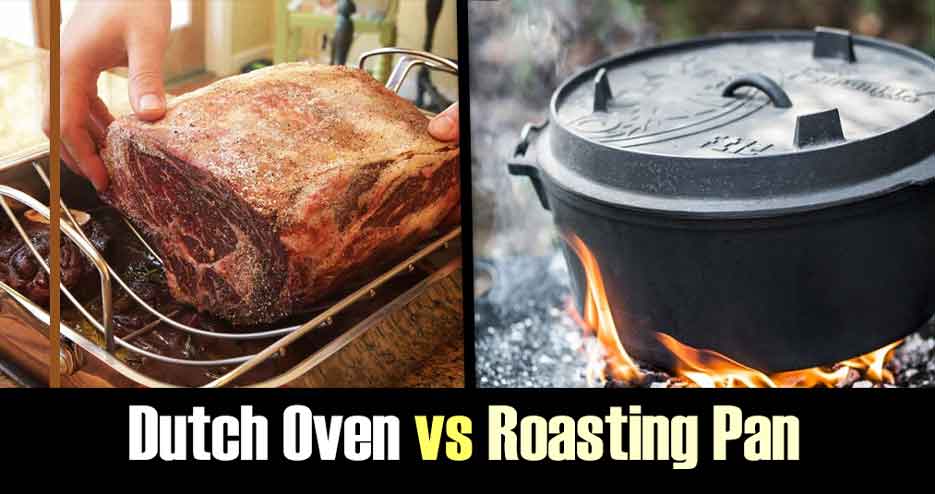
Dutch Oven vs Roasting Pan
Dutch oven and roasting pan are similar, but some recipes can cook better in the specific one.
Size of Roasting Pan and Dutch Oven
Dutch oven comes in various sizes, from small to large, depending on your preference. 4-person food size is 5 to 8 quartz, and the comprehensive size range is 1 to 13 quartz. One quartz size is best for cooking small dishes. And you can make at least 12 people’s meals in 13 Dutch quartz ovens.
Roasting pans are often available in sizes ranging from 9 x 13 inches to 16 x 20 inches or larger. They are designed to hold 1 or 2 birds and carry small to 12-pound chickens.
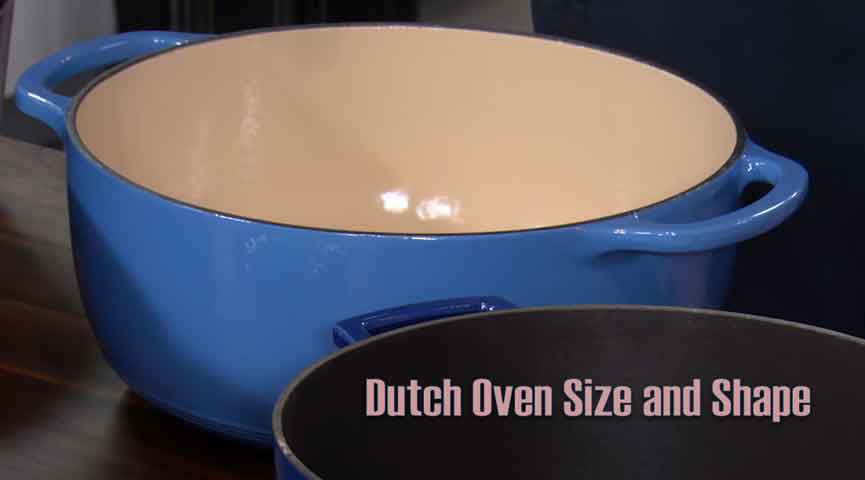
Also, the depth of a Dutch oven is more profound than a roasting pan; you can put more significant cuts of meat or more liquid in a Dutch oven. The depth of the roasting pan is generally flatter and broader. It gives more surface to roasting vegetables and meat.
Weight Differences
Dutch ovens are cast iron, and roasting pans are made of stainless steel. Cast iron is heavier than stainless steel. So a medium-sized Dutch oven could be 11 lbs, and when you fill it with food, the weight could be up to 20 lbs.
Roasting pans are lightweight and easy to fit. The weight of the roasting pan does not matter if it is sturdy enough. You can carry and fit it anywhere.
Shape [ Round vs. Oval]
Dutch oven comes in various shapes, and which type of shape suits you depends on your cooking purpose. The most common shapes are round and oval shape. The surface area of the round Dutch area is suitable for liquidy-type foods and others. Oval shapes are suitable for whole birds.
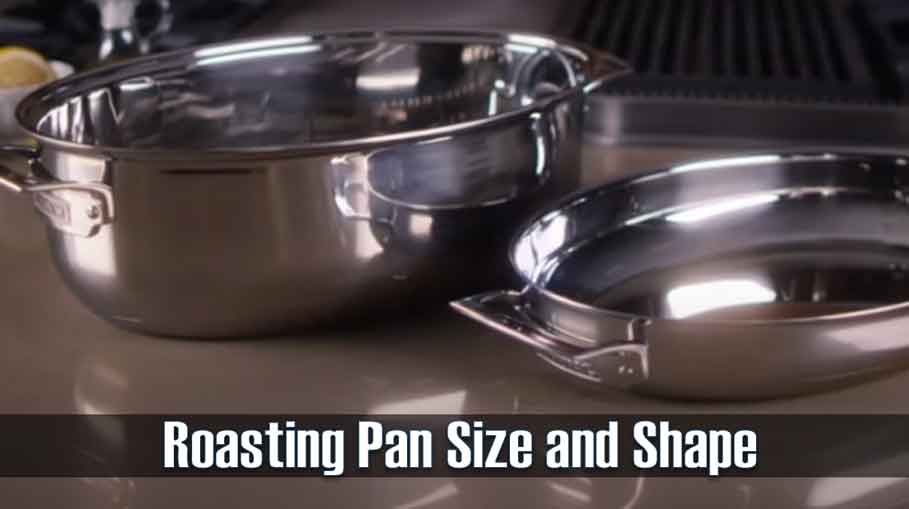
A roasting pan is a large, shallow pan with low sides. It is used for roasting meat or poultry in the oven. The shape could be similar to a Dutch oven.
Materials
Dutch ovens are made of cast iron, and they have thick walls with tightly fitted lids. Also, some are made of rugged anodized aluminum, copper, and brass with nonstick coating. Copper and brass are expensive, so cast iron Dutch ovens are popular now. The handles are made of non-conductive materials, and the cooking surface is coated with enamel.
The market has various types of roasting pans made with copper, cast iron, glass, etc. the cheapest roasting pan are made with aluminum foil and are disposable. Stainless steel, coated enamelware, and cast iron have a nonstick coating; you can clean them quickly and faster. You have to find the suitable one for you.
Functional Difference
The cooking function is slightly different in a Dutch oven and roasting pan. You can use both for roasting; just roasting the pan gives browner and crispier results. A Dutch oven is better for baking because it has tight fitted lit, so the oven automatically steams the heat inside and makes soft and fluffy bread.
A roasting pan is not used for baking. But you can still use it for steam using a rack. Broth, stews, and soup can make better in a Dutch oven. Roasting pans are not for making soup or stews; you can heat them. Roasting pans are mainly for roasting and one-sheet meal. You can make lasagna, pot pie, etc.
Cooking Temperature
The roasting pan and Dutch oven are made of different materials. A Dutch oven is cast iron, and a Dutch oven has thicker walls. So it distributes heat slowly and takes a long time to cook food. On the other hand, stainless steel and aluminum distribute heat quickly.
Heat Retention 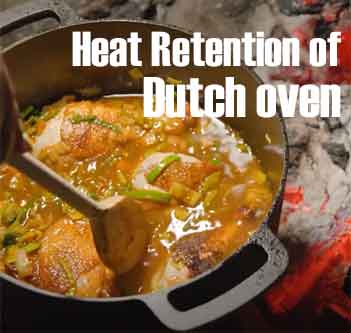
Cast iron can retain heat for a few hours to keep the food warm without monitoring it. That’s what makes the Dutch oven great for making soup and stews.
The roasting pan does not have a heat retention system as it is made with stainless steel, so you have to monitor the cooking temperature constantly, and it will cool down completely at room temperature.
Cooking Surface
The cooking surface of the Dutch oven is a flat bottom.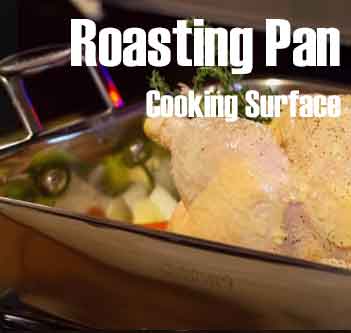
The lid position is at the top of the oven. Also, the lid sits tightly, so the heat distribution process is quick here.
The roasting pan has no lid, so there is no barrier to heat, and you can only cook shallow dishes. The cooking surface is not ideal for larger-cut food.
Some roasting pan has a lid, but they are smaller than the pan.
Durability
Dutch ovens are vintage cooking appliances as cast iron is highly durable, so they serve long. They are also nonstick, meaning they are easy to clean, and you don’t have to use harsh chemicals to clean them.
Roasting pans are lightweight but not as durable as Dutch ovens. However, the roasting pan can perform for at least 3 to 5 years if appropriately maintained.
Types of Food They Are Good At
A roasting pan means it is ideal for roasting. You can be able to do almost everything that a Dutch oven can do. But they are better suited for browning food, heating food, roasting a bird, etc.; conversely, dutch ovens are suitable for making stews, braising meat, baking, etc.
Cost
Dutch ovens are more expensive than the roasting pan, but this investment guaranty the longtime cooking appliance. However, some models are affordable. The price range ranges from $150 to $200 for a high-quality Dutch oven. And roasting pan price starts from $50 to $150.
Can You Use a Roaster Pan As a Dutch Oven?
The roasting pan and Dutch oven are not the same; they look different and distribute heat differently. So their cooking time is different too. The Dutch oven has a heavy lid that tightly sits on the top, so the heat remains inside and pressures the food to cook quickly.
If you want to use the roasting pan as a Dutch oven, the pan will need a heavy lid, just like a Dutch oven, to cook food quickly and evenly. With a lid, you can also use it for baking and to make more flavorful dishes. The market has various types of lids, especially for roasting pans. Choose a suitable one, and you are good to go.
